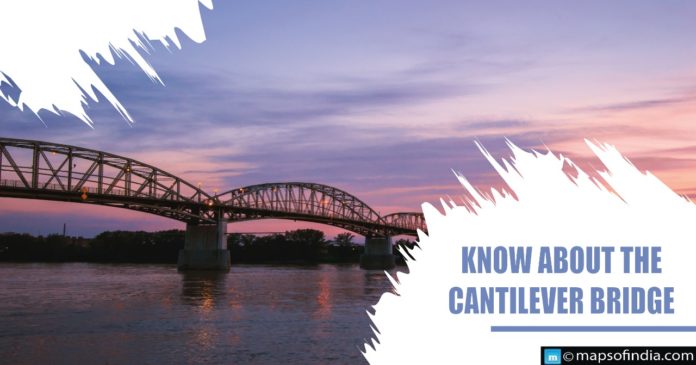Any bridge with a cantilever span is known as a cantilever bridge. A cantilever is a construction that is only held together by one of its affixed limbs or ends. While maintaining the bridge, its opposite end extends horizontally into space.
A cantilever can be compared to a diving board to understand it better. Only one side of a diving board is anchored down, allowing the other end to bear a diver’s weight. For cantilever bridges, the lower section of each cantilever is fixed to the ground, while the higher end of the cantilever holds up the bridge itself.
It is possible to employ simple beams to support cantilever bridges, such as the Kingsgate Bridge in Durham. However, steel trusses or concrete girders will be necessary for bridges like the Forth Bridge in Scotland, carrying cars or trains.
Who invented the Cantilever bridges?
Heinrich Gerber constructed the first cantilever bridge in 1867. He built the Regnitz River and Main River bridges in Bamberg and Haßfurt, respectively.
The cantilever bridge was sometimes referred to as the Gerber Beam since Gerber was the first to build one. Soon after, the High Bridge of Kentucky, the Niagara Cantilever Bridge, and the Poughkeepsie Bridge were constructed.
Although the materials may have evolved, cantilever Bridges are built using Heinrich Gerber’s original design.
Regarding cantilever bridge materials, what do you think could be the best?
- Because cantilever bridges come in various shapes and sizes to accommodate a wide range of traffic, a wide range of cantilever bridge materials are available for use in their construction.
- Wood was used to build some cantilever bridges in Asia. It is a functional design. However, it would collapse under the weight of a significant person. Metals like steel and iron are commonly used in cantilever bridge construction.
- Fifty-eight thousand tonnes of steel were used to construct the Forth Bridge in Scotland. Additionally, the bridge employs iron to stabilize the cantilevers, preventing them from tipping or tilting under their weight.
- Even though the Alamillo Bridge’s design differs much from the Forth Bridge, it is steel reinforced with concrete.
Cantilever bridges pros
Cantilever bridges are preferred over other types of bridges for a variety of reasons:
- The construction of cantilever bridges is less disruptive. A lot of space is needed to build most bridges, which can cause roads to be shut down or boats to be stranded on the water. Cantilever bridges provide plenty of room for driving, allowing for a smooth traffic flow.
- Falsework, a temporary structure used to support the bridge while it is being constructed, is not required for most cantilever bridge components. As a result, cantilever bridges are well-suited to flood-prone environments such as steep gorges and rivers, where falsework construction would be risky.
- Carrying large weights is also an excellent use for cantilever bridges. Cantilever bridges are incredibly robust because of their design. Decks on cantilever bridges have a higher density than those on other types of bridges, making them more rigid. It would be instrumental in the event of an overcrowded train on a bridge.
Cantilever bridge cons
- Cantilever bridges have their pros and downsides. Their weight and size are expensive to create and maintain as a result of their weight and size.
- If you live in a location that experiences extreme weather, you may want to avoid cantilever bridges.





